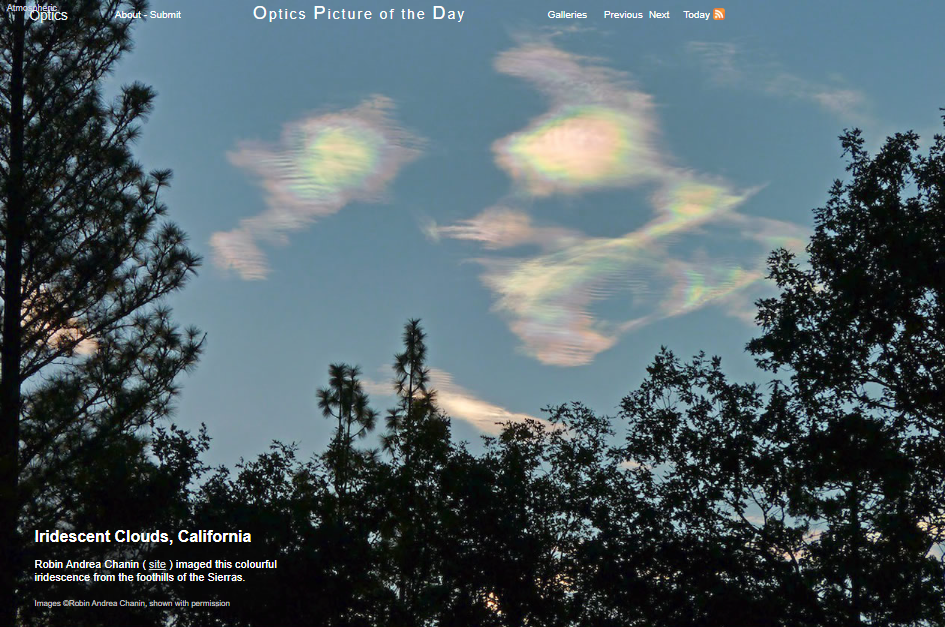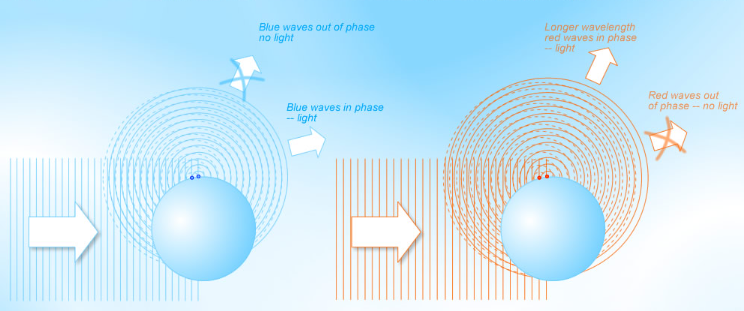OPOD - Iridescence and diffraction, California
OPOD - Iridescence and Diffraction: A Captivating Phenomenon in California's Sky
Iridescence, a mesmerizing optical phenomenon, graces the skies of California, leaving onlookers in awe of its vibrant colors and ethereal beauty. Captured by Robin Andrea Chanin from the foothills of the Sierras, these captivating images showcase the interplay between light and small particles suspended in the atmosphere.
When we witness iridescence in the sky, it serves as a reminder that light possesses wave properties and interacts with minuscule entities such as water droplets, ice crystals, and even pollen grains. These tiny particles act as scattering agents, causing light to disperse and create stunning displays of colors.
To understand the mechanics behind iridescence, let's imagine plane waves of blue sunlight scattering from a cloud water droplet. As the waves radiate outward from every point on the droplet's rim, they can either be in-phase or out of phase depending on the direction. In-phase waves reinforce each other, resulting in the emission of blue light. Conversely, out-of-phase waves cancel each other out, leading to darkness. This fascinating phenomenon is known as interference or diffraction, with the two terms being largely synonymous.
In a similar geometric setup but with longer wavelength red light, different directions yield varying levels of brightness and darkness. Consequently, a cloud composed of droplets of similar size can exhibit red hues in certain directions while displaying different colors elsewhere. The interplay between viewing angles, sun direction, and local variations in cloud droplet size further contributes to the kaleidoscope of colors observed during iridescence events.
As we delve deeper into the intricacies of iridescence and diffraction, it is important to note that these phenomena are influenced by various factors. The size and composition of the scattering particles play a significant role in determining the colors observed. Additionally, the angle at which sunlight interacts with these particles affects the intensity and appearance of iridescence in the sky.
While California's skies provide a stunning backdrop for iridescence and diffraction, these phenomena are not exclusive to the region. They can be observed in different parts of the world under specific atmospheric conditions. From shimmering clouds to radiant rainbows, nature constantly surprises us with its ability to create awe-inspiring displays.
In conclusion, iridescence and diffraction are captivating optical phenomena that showcase the wave properties of light and the scattering of small particles in the atmosphere. Through the interplay of interference and diffraction, sunlight interacts with water droplets, ice crystals, and pollen grains to create stunning displays of colors. The specific colors observed during iridescence events depend on various factors such as particle size, composition, viewing angles, and sun direction. Whether witnessed in California or elsewhere in the world, iridescence serves as a reminder of nature's ability to mesmerize and enchant us with its extraordinary beauty.

Iridescent Clouds, California
Robin Andrea Chanin ( site ) imaged this colourful iridescence from the foothills of the Sierras.
Images ©Robin Andrea Chanin, shown with permission

Iridescence writes large in the sky that light has wave properties and that there are small things, be they tiny water droplets, ice crystals or even pollen grains, to scatter it.
Imagine (far left) plane waves of blue sunlight scattering from a cloud water droplet. Outgoing spherical waves radiate out from every point on the drop�s rim. For simplicity the diagram shows waves from only two points. In some directions the outgoing waves are in-phase. and radiate blue light � in others they are out of phase, cancel, and there is no light. The process is interference or diffraction � the two terms are more or less synonymous.
At right is the exact same geometry but with longer wavelength red light. There are different directions for brightness and darkness. A cloud of similar size droplets will appear red in some directions and different colours elsewhere.
Different viewing angles, sun direction and local variations in cloud droplet size all influence the colours.
Note: this article has been automatically converted from the old site and may not appear as intended. You can find the original article here.
Reference Atmospheric Optics
If you use any of the definitions, information, or data presented on Atmospheric Optics, please copy the link or reference below to properly credit us as the reference source. Thank you!
-
<a href="https://atoptics.co.uk/blog/opod-iridescence-and-diffraction-california/">OPOD - Iridescence and diffraction, California</a>
-
"OPOD - Iridescence and diffraction, California". Atmospheric Optics. Accessed on April 19, 2024. https://atoptics.co.uk/blog/opod-iridescence-and-diffraction-california/.
-
"OPOD - Iridescence and diffraction, California". Atmospheric Optics, https://atoptics.co.uk/blog/opod-iridescence-and-diffraction-california/. Accessed 19 April, 2024
-
OPOD - Iridescence and diffraction, California. Atmospheric Optics. Retrieved from https://atoptics.co.uk/blog/opod-iridescence-and-diffraction-california/.